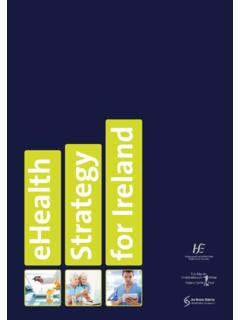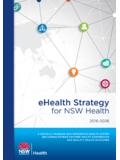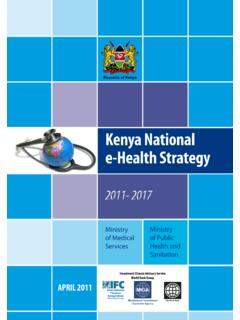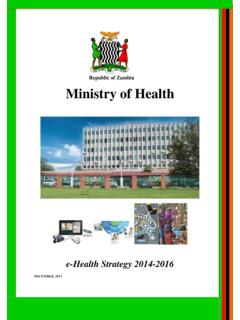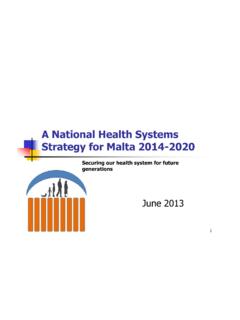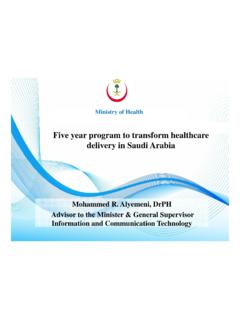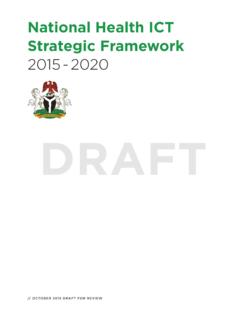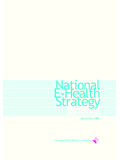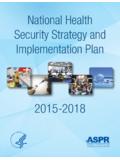Transcription of National eHealth Strategy Toolkit - WHO
1 Page iNational eHealth Strategy ToolkitOverview World Health Organization and International Telecommunication Union 2012 All rights reserved. Publications of the World Health Organization are available on the WHO web site ( ) or can be purchased from WHO Press, World Health Organization, 20 Avenue Appia, 1211 Geneva 27, Switzerland (tel.: +41 22 791 3264; fax: +41 22 791 4857; e-mail: Requests for permission to reproduce or translate WHO publications whether for sale or for noncommercial distribution should be addressed to WHO Press through the WHO web site ( ).Publications of the International Telecommunication Union can be obtained from ITU Bookshop, International Telecommunication Union, Place des Nations, 1211 Geneva 20, Switzerland ( ).)
2 The designations employed and the presentation of the material in this publication do not imply the expression of any opinion whatsoever on the part of the World Health Organization or the International Telecommunication Union concerning the legal status of any country, territory, city or area or of its authorities, or concerning the delimitation of its frontiers or boundaries. Dotted lines on maps represent approximate border lines for which there may not yet be full mention of specific companies or of certain manufacturers products does not imply that they are endorsed or recommended by the World Health Organization or the International Telecommunication Union in preference to others of a similar nature that are not mentioned.
3 Errors and omissions excepted, the names of proprietary products are distinguished by initial capital reasonable precautions have been taken by the World Health Organization and the International Telecommunication Union to verify the information contained in this publication. However, the published material is being distributed without warranty of any kind, either expressed or implied. The responsibility for the interpretation and use of the material lies with the reader. In no event shall the World Health Organization or the International Telecommunication Union be liable for damages arising from its use. page 1 National eHealth Strategy ToolkitOverviewThe case for eHealthThe National eHealth Strategy Toolkit reflects the growing impact that eHealth is bringing to the delivery of health care around the world today, and how it is making health systems more efficient and more responsive to people s needs and expectations.
4 Technological advances, economic investment, and social and cultural changes are also contributing to the realization that the health sector must now integrate technology into its way of doing business. The daily business of health in all its aspects from individual care to humanitarian action relies on information and communication and, increasingly, on the technologies that enable it, at every level and in every country. Countries that are now seeking to develop their own eHealth Strategy will, however, face many challenges. The Toolkit reflects those challenges and acts as a comprehensive guide on how to overcome them for the benefit of public the major United Nations agencies for health and telecommunications respectively, the World Health Organization (WHO) and the International Telecommunication Union (ITU) have long recognized the importance of collaboration for eHealth in their global resolutions1, which encourage countries to develop National eHealth strategies: this Toolkit supports those defines eHealth as the use of information and communication technologies (ICT) for health.
5 In its broadest sense, eHealth is about improving the flow of information, through electronic means, to support the delivery of health services and the management of health systems. The need for National planning Experience shows that harnessing ICT for health requires strategic and integrated action at the National level, to make the best use of existing capacity while providing a solid foundation for investment and innovation. Establishing the main directions as well as planning the detailed steps needed is essential to achieving longer-term goals such as health sector efficiency, reform or more fundamental transformation.
6 Collaboration between the health and ICT sectors, both public and private, is central to this effort. Ministries of health play a pivotal role, not only in meeting people s needs for care and protecting public health, but also in preserving health systems through uncertain times. Ministries of information technology and telecommunications are crucial to development in all spheres, and can make a vital contribution to the health sector. Common goals and a predictable ICT environment enable coordinated action: building consensus on policy, facilitating better use of shared resources and involvement of the private sector, and investment in skills and infrastructure to improve health World Health Assembly Resolution (2005) and ITU World Telecomunication Development Conference Resolution 65 (2010).
7 Page 2A vision for National eHealthA key element of the Toolkit is a National eHealth vision. This explains why a National approach to eHealth is needed, what a National eHealth plan will need to achieve, and how it will be done. Why this is the strategic context for eHealth , encompassing the health of the population, the status of the health system, the health and development priorities, and the resulting implications for eHealth . What this is the role eHealth will play in the achievement of health sector goals. It serves as a high-level message for policy-makers that answers the question of where does our country want to go with health and how will eHealth help us get there?
8 How this gives the various eHealth components or building blocks that must be in place to realize the National eHealth with stakeholdersMany stakeholders, including those from sectors other than the health sector, have an interest in eHealth and are keen to contribute to the process. It is essential from the beginning to understand their views, and to gain their collaboration, support and endorsement of the outcomes of the eHealth planning process. Such an inclusive approach not only builds relationships; it also gains valuable perspectives on what eHealth should deliver. This commitment to open communication and a willingness to consider the views and interests of diverse groups needs to be nurtured throughout the process.
9 Understanding stakeholders perspectives gives a much fuller picture of a country s technical, political and social Toolkit : what it is and who it is forThe National eHealth Strategy Toolkit is a resource for developing or revitalizing a country s eHealth Strategy , from countries just setting out to those that have already invested significantly in some countries, eHealth integration is well-advanced; in others it has barely begun. Some countries are seeking to build on promising results from pilot initiatives, establish foundations for scaling up eHealth projects, or update strategies to reflect changing circumstances.
10 For all countries, whatever their level of eHealth advancement, the Toolkit is a practical, comprehensive, step-by-step guide. It will help governments develop their own eHealth Strategy , tailored to their own National policies, resources and requirements, and to the expectations of their citizens. The Toolkit is directed chiefly towards the most relevant government departments and agencies, particularly the ministry of health, and the ministries of information technology and telecommunications. Although comprehensive, the Toolkit does not need to be comprehensively employed: individual governments and their departments can choose, refine and develop the parts that are best for them, and create their own unique eHealth will also be useful to decision-makers who see the need for a National eHealth plan but are uncertain how to proceed in order to develop one.










